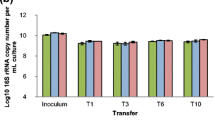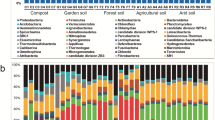Abstract
The extracellular enzyme activity and changes in soil bacterial community during the growth of the ligninolytic fungusPleurotus ostreatus were determined in nonsterile soil with low and high available carbon content. In soil withP. ostreatus, the activity of ligninolytic enzymes laccase and Mn-peroxidase was several orders of magnitude higher than in soil without the fungus. Addition of lignocellulose to soil increased the activity of cellulolytic fungi and the production of Mn-peroxidase byP. ostreatus. The counts of heterotrophic bacteria were more significantly affected by the presence of lignocellulose than byP. ostreatus. The effects of both substrate addition and time (succession) were more significant factors affecting the soil bacterial community than the presence ofP. ostreatus. Bacterial community structure was affected by fungal colonization in low carbon soil, where a decrease of diversity and changes in substrate utilization profiles were detected.
Similar content being viewed by others
Abbreviations
- ABTS:
-
2,2′-azinobis-3-ethylbenzothiazoline-6-sulfonic acid
- CFU:
-
colony forming unit(s)
- CTC:
-
circadian temperature cycle
- DMAB:
-
3,3-dimethylaminobenzoic acid
- EDTA:
-
ethylenediamine tetraacetate
- MBTH:
-
3-methyl-2-benzothiazolinone hydrazone
- MnP:
-
manganese peroxidase
- PAH:
-
oligocyclic (‘polycyclic’) aromatic hydrocarbons
- PO:
-
treatment containing nonsterile soil inoculated withP. ostreatus
- POS:
-
treatment containing nonsterile soil with straw addition inoculated withP. ostreatus
- SO:
-
treatment containing nonsterile soil
- SOS:
-
treatment containing nonsterile soil with straw addition
References
van Aarle I.M., Olsson P.A., Soderstrom B.: Arbuscular mycorrhizal fungi respond to the substrate pH of their extraradical mycelium by altered growth and root colonization.New Phytol. 155, 173–182 (2002).
Ali T.A., Wainwright A.M.: Growth ofPhanerochaete chrysosporium in soil and its ability to degrade the fungicide benomyl.Biores.Technol. 49, 197–201 (1994).
Andersson B.E., Welinder L., Olsson P.A., Olsson S., Henrysson T.: Growth of inoculated white-rot fungi and their interactions with the bacterial community in soil contaminated with polycyclic aromatic hydrocarbons, as measured by phospholipid fatty acids.Biores.Technol. 73, 29–36 (2000).
Andersson B.E., Lundstedt S., Tornberg K., Schnurer Y., Oberg L.G., Mattiasson B.: Incomplete degradation of polycyclic aromatic hydrocarbons in soil inoculated with wood-rotting fungi and their effect on the indigenous soil bacteria.Environ. Toxicol.Chem. 22, 1238–1243 (2003).
Baborová P., Móder M., Baldrian P., Cajthamlová K., Cajthaml T.: Purification of a new manganese peroxidase of the white-rot fungusIrpex lacteus and degradation of polycyclic aromatic hydrocarbons by the enzyme.Res.Microbiol. 157, 248–253 (2006).
Baldrian P.: Increase of laccase activity during interspecific interactions of white-rot fungi.FEMS Microbiol.Ecol. 50, 245–253 (2004).
Baldrian P.: Fungal laccases — occurence and properties.FEMS Microbiol.Rev. 30, 215–242 (2006).
Baldrian P., in der Wiesche C., Gabriel J., Nerud F., Zadrazil F.: Influence of cadmium and mercury on activities of ligninolytic enzymes and degradation of polycyclic aromatic hydrocarbons byPleurotus ostreatus in soil.Appl.Environ.Microbiol. 66, 2471–2478 (2000).
Baldrian P., Valášková V., Merhautová V., Gabriel J.: Degradation of lignocellulose byPleurotus ostreatus in the presence of copper, manganese, lead and zinc.Res.Microbiol. 156, 670–676 (2005).
de Boer W., Folman L.B., Summerbell R.C., Boddy L.: Living in a fungal world: impact of fungi on soil bacterial niche development.FEMS Microbiol.Rev. 29, 795–811 (2005).
Bogan B.W., Schoenike B., Lamar R.T., Cullen D.: Manganese peroxidase mRNA and enzyme activity levels during bioremediation of polycyclic aromatic hydrocarbon-contaminated soil withPhanerochaete chrysosporium.Appl.Environ.Microbiol. 62, 2381–2386 (1996a).
Bogan B.W., Schoenike B., Lamar R.T., Cullen D.: Expression oflip genes during growth in soil and oxidation of anthracene byPhanerochaete chrysosporium.Appl.Environ.Microbiol. 62, 3697–3703 (1996b).
Bogan B.W., Lamar R.T., Burgos W.D., Tien M.: Extent of humification of anthracene, fluoranthene, and benzo[a]pyrene byPleurotus ostreatus during growth in PAH-contaminated soils.Lett.Appl.Microbiol. 28, 250–254 (1999).
Canet R., Birnstingl J.G., Malcolm D.G., Lopez-Real J.M., Beck A.J.: Biodegradation of polycyclic aromatic hydrocarbons (PAHs) by native microflora and combinations of white-rot fungi in a coal-tar contaminated soil.Biores.Technol. 76, 113–117 (2001).
Criquet S., Tagger S., Vogt G., Iacazio G., Le Petit J.: Laccase activity of forest litter.Soil Biol.Biochem. 31, 1239–1244 (1999).
Criquet S., Farnet A.M., Tagger S., Le Petit J.: Annual variations of phenol oxidase activities in an evergreen oak litter: influence of certain biotic and abiotic factors.Soil Biol.Biochem. 32, 1505–1513 (2000).
Criquet S., Tagger S., Vogt G., Le Petit J.: Endoglucanase and β-glycosidase activities in an evergreen oak litter: annual variation and regulating factors.Soil Biol.Biochem. 34, 1111–1120 (2002).
D’Annibale A., Ricci M., Leonardi V., Quaratino D., Mincione E., Petruccioli M.: Degradation of aromatic hydrocarbons by white-rot fungi in a historically contaminated soil.Biotechnol.Bioeng. 90, 723–731 (2005).
Eggen T., Majcherczyk A.: Removal of polycyclic aromatic hydrocarbons (PAH) in contaminated soil by white rot fungusPleurotus ostreatus.Int.Biodeter.Biodegrad. 41, 111–117 (1998).
Eggen T., Sveum P.: Decontamination of aged creosote polluted soil: the influence of temperature, white rot fungusPleurotus ostreatus, and pretreatment.Int.Biodeter.Biodegrad. 43, 125–133 (1999).
Eggert C.: Laccase-catalyzed formation of cinnabarinic acid is responsible for antibacterial activity ofPycnoporus cinnabarinus.Microbiol.Res. 152, 315–318 (1997).
Falcon M.A., Rodriguez A., Carnicero A., Regalado V., Perestelo V., Milstein O., De la Fuente G.: Isolation of microorganisms with lignin transformation potential from soil of Tenerife island.Soil Biol.Biochem. 27, 121–126 (1995).
Fernandez-Sanchez J.M., Rodriguez-Vazquez R., Ruiz-Aguilar G., Alvarez P.J.J.: PCB biodegradation in aged contaminated soil: interactions between exogenousPhanerochaete chrysosporium and indigenous microorganisms.J.Environ.Sci.Health Part A — Toxic/Hazard.Subst.Environ.Eng. 36, 1145–1162 (2001).
Filip Z., Claus H., Dippell G.: Degradation of humic substances by soil microorganisms — a review.Z.Pflnahr.Bodenkd. 161, 605–612 (1998).
Fragoeiro S., Magan N.: Enzymatic activity, osmotic stress and degradation of pesticide mixtures in soil extract liquid broth inoculated withPhanerochaete chrysosporium andTrametes versicolor.Environ.Microbiol. 7, 348–355 (2005).
Gramss G.: Activity of oxidative enzymes in fungal mycelia from grassland and forest soils.J.Basic Microbiol. 37, 407–423 (1997).
Gramss G., Kirsche B., Voigt K.D., Gunther T., Fritsche W.: Conversion rates of five polycyclic aromatic hydrocarbons in liquid cultures of fifty-eight fungi and the concomitant production of oxidative enzymes.Mycol.Res. 103, 1009–1018 (1999a).
Gramss G., Voigt K.D., Kirsche B.: Degradation of polycyclic aromatic hydrocarbons with three to seven aromatic rings by higher fungi in sterile and unsterile soils.Biodegradation 10, 51–62 (1999b).
Gryndler M., Hršelová H., Klír J., Kubát J., Votruba J.: Long-term fertilization affects the abundance of saprotrophic microfungi degrading resistant forms of soil organic matter.Folia Microbiol. 48, 76–82 (2003).
Harch B.D., Correll R.L., Meech W., Kirkby C.A., Pankhurst C.E.: Using the Gini coefficient with BIOLOG substrate utilization data to provide an alternative quantitative measure for comparing bacterial soil communities.J.Microbiol.Meth. 30, 91–101 (1997).
Hatakka A.: Biodegradation of lignin, pp. 129–179 in M. Hofrichter, A. Steinbüchel (Eds):Lignin, Humic Substances and Coal. Wiley-VCH, Weinheim 2001.
Hofrichter M.:Review: Lignin conversion by manganese peroxidase (MnP).Enzyme Microb.Technol. 30, 454–466 (2002).
Kölbel-Boelke J., Tienken B., Nehrkorn A.: Microbial communities in the saturated groundwater environment. 1. Methods of isolation and characterization of heterotrophic bacteria.Microb.Ecol. 16, 17–29 (1988).
Kotterman M.J.J., Vis E.H., Field J.A.: Successive mineralization and detoxification of benzo[a]pyrene by the white rot fungusBjerkandera sp. strain BOS55 and indigenous microflora.Appl.Environ.Microbiol. 64, 2853–2858 (1998).
Kourtev P.S., Ehrenfeld J.G., Huang W.Z.: Enzyme activities during litter decomposition of two exotic and two native plant species in hardwood forests of New Jersey.Soil Biol.Biochem. 34, 1207–1218 (2002).
Lang E., Kleeberg I., Zadrazil F.: Competition ofPleurotus sp. andDichomitus squalens with soil microorganisms during lignocellulose decomposition.Biores.Technol. 60, 95–99 (1997a).
Lang E., Eller G., Zadrazil F.: Lignocellulose decomposition and production of ligninolytic enzymes during interaction of white rot fungi with soil microorganisms.Microb.Ecol. 34, 1–10 (1997b).
Lang E., Nerud F., Zadrazil F.: Production of ligninolytic enzymes byPleurotus sp. andDichomitus squalens in soil and lignocellulose substrate as influenced by soil microorganisms.FEMS Microbiol.Lett. 167, 239–244 (1998).
Lang E., Kleeberg I., Zadrazil F.: Extractable organic carbon and counts of bacteria near the lignocellulose-soil interface during the interaction of soil microbiota and white rot fungi.Biores.Technol. 75, 57–65 (2000).
Luis P., Kellner H., Martin F., Buscot F.: A molecular method to evaluate basidiomycete laccase gene expression in forest soils.Geoderma 128, 18–27 (2005).
Martens R., Zadrazil F.: Screening of white-rot fungi for their ability to mincralize polycyclic aromatic hydrocarbons in soil.Folia Microbiol. 43, 97–103 (1998).
Ngo T.T., Lenhoff H.M.: A sensitive and versatile chromogenic assay for peroxidase and peroxidase-coupled reactions.Anal.Biochem. 105, 389–397 (1980).
Niku-Paavola M.L., Raaska L., Itävaara M.: Detection of white-rot fungi by a non-toxic stain.Mycol.Res. 94, 27–31 (1990).
Rama R., Sigoillot J.C., Chaplain V., Asther M., Jolivalt C., Mougin C.: Inoculation of filamentous fungi in manufactured gas plant site soils and PAH transformation.Polycycl.Arom.Comp. 18, 397–414 (2001).
Rayner A.D.M., Boddy L.:Decomposition of Wood: Its Biology and Ecology. John Wiley, Chichester (UK) 1998.
Rodriguez A., Perestelo F., Carnicero A., Regalado V., Perez R., De la Fuente G., Falcon M.A.: Degradation of natural lignins and lignocellulosic substrates by soil-inhabiting fungi imperfecti.FEMS Microbiol.Ecol. 21, 213–219 (1996).
Ruttimann C., Vicuna R., Mozuch M.D., Kirk T.K.: Limited bacterial mineralization of fungal degradation intermediates from synthetic lignin.Appl.Environ.Microbiol. 57, 3652–3655 (1991).
Saparrat M.C.N., Guillén F.: Ligninolytic ability and potential biotechnology applications of the South American fungusPleurotus laciniatocrenatus.Folia Microbiol. 50, 155–160 (2005).
Steffen K.T., Hatakka A., Hofrichter M.: Degradation of humic acids by the litter-decomposing basidiomyceteCollybia dryophila.Appl.Environ.Microbiol. 68, 3442–3448 (2002).
Tornberg K., Baath E., Olsson S.: Fungal growth and effects of different wood decomposing fungi on the indigenous bacterial community of polluted and unpolluted soils.Biol.Fertil.Soils 37, 190–197 (2003).
Tucker B., Radtke C., Kwon S.I., Anderson A.J.: Suppression of bioremediation byPhanerochaete chrysosporium by soil factors.J.Hazard.Mater. 41, 251–265 (1995).
Tuomela M., Lyytikaeinen M., Oivanen P., Hatakka A.: Mineralization and conversion of pentachlorophenol (PCP) in soil inoculated with the white-rot fungusTrametes versicolor.Soil Biol.Biochem. 31, 65–74 (1999).
Wells J.M., Harris M.J., Boddy L.: Encounter with new resources causes polarized growth of the cord-forming basidiomycetePhanerochaete velutina on soil.Microb.Ecol. 36, 372–382 (1998).
in der Wiesche C., Martens R., Zadrazil F.: Two-step degradation of pyrene by white-rot fungi and soil microorganisms.Appl. Microbiol.Biotechnol. 46, 653–659 (1996).
Author information
Authors and Affiliations
Corresponding author
Additional information
This study was supported by theCzech Science Foundation (204/02/P100 and 526/05/0168) and by theInstitutional Research Concept no. AV0Z 5020 0510 of theInstitute of Microbiology, Acad. Sci. Czech Rep.
Rights and permissions
About this article
Cite this article
Šnajdr, J., Baldrian, P. Production of lignocellulose-degrading enzymes and changes in soil bacterial communities during the growth ofPleurotus ostreatus in soil with different carbon content. Folia Microbiol 51, 579–590 (2006). https://doi.org/10.1007/BF02931623
Received:
Revised:
Issue Date:
DOI: https://doi.org/10.1007/BF02931623




